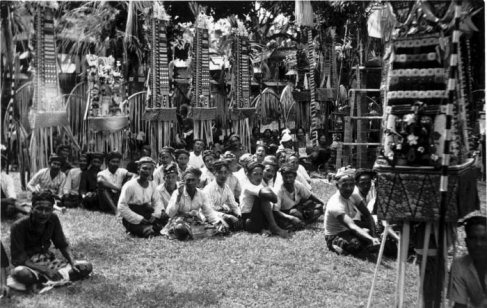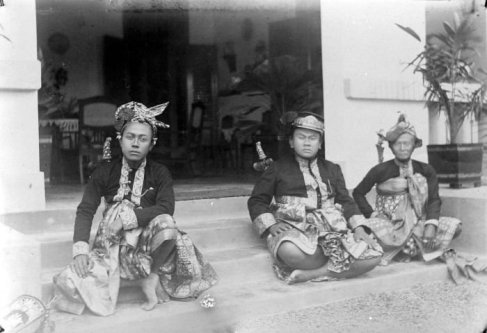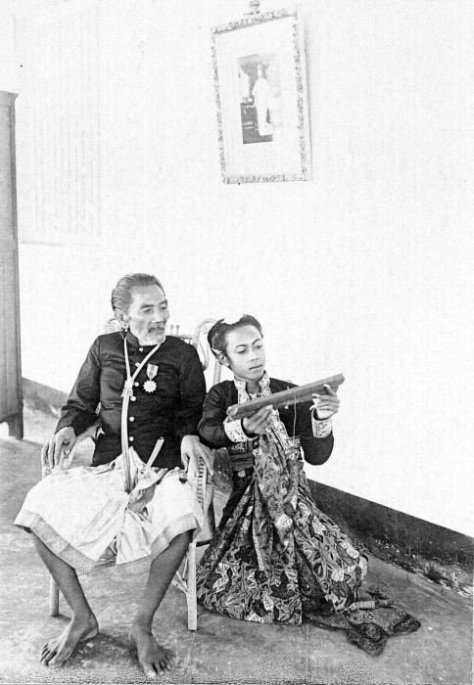OLD HINDU BALINESE ART
Already in the records of Chinese travelers of the fifth century it is mentioned that in the.country of Poli, perhaps Bali, there were Hindu princes, and that the travelers were received by priests who danced around them blowing conch-shells. Bali was already a colony of the Central Javanese kingdom of Mataram, the earliest recorded ruler of which was, according to Stutterheim, King Sandjaya or Sanjaya (A.D- 732) of the Sailendra dynasty, who ruled also over southern Sumatra.
The Sailendras where Mahayanic Buddhists, and their highly developed art. was like that of the great Gupta period of India. Sivaism was introduced towards the middle of the ninth century and, by degrees, the power of the Sailendras waned, but it was within this period, from the seventh to the ninth centuries, the golden age of Javanese art, that the finest monuments of Java were built, the Buddhist Borobudur and the Sivaist Lora Djongrang in Prambanan. Soon this great civilization disappeared mysteriously and Bali came under the rule of independent kings in Pedieng and Bedulu. From their time we have remains of the classic style in the neighborhood of the present villages of the same names, some in ruined temples, in caves, or among the rice fields, in the strip of land between the rivers Pakrisan and Petanu, where so many of the antiquities of Bali are found. Towards the beginning of the eleventh century there was a renaissance in East Java, in Kediri, brought about by the Balinese-born king Erlangga. Under him Bali became again an integral part of Java and classicism received a new impetus. It was Erlangga who instituted Javanese as the official language of Bali. Tantric black magic seems to have played an important part in Erlangga’s time, and while be was having trouble with his greatest political enemy, his own mother, who bad sworn to destroy his kingdom by the black arts, Erlangga’s brother ruled Bali in his name. This brother was buried (according to Stutterheim) in the spectacular ” Kings’ tombs ” in Gunung Kawi near Tampaksiring.
Among the important relics of the ancient period are the following:
Gunung Kawi: On the banks of the river Pakrisan, descending a steep ravine, is a group of sober, in decorated monuments shaped like the ancient burial towers (tiandif), hewn out of the solid rock, each inside, of a niche, four on one side and five on the other. To the right of the main group is a sort of monastery with coves also carved out of the rock, arranged around a central cell with a platform in the center The monuments are supposed to belong to the eleventh century, when cremation had not yet been introduced into Bali, and Lekkerkerker thinks the cells were probably destined to expose the corpses to be obliterated by decay and wild animals, such as was the custom among Indonesians, and as is still practiced in Sembiran in Bali and by the Toradjas in Celebes, where it is now forbidden by the Dutch. The monuments were only discovered in io2o, but the Balincse knew them, and saw them with reverence because they attributed them to the giant of mythical times, Kbo Iwa’, who is supposed to have carved all the ancient monuments with his own fingernails. The natives formerly called the tombs DiaM, but the present placename, Gunung Kawi, means ” mountain of poetry ” or ” mountain of antiquity.”
Bukit Darrna: In Kutri near Bedulu there is another antiquity of the classic period, also related to Erlangga. It is the beautiful statue of Mabendradatta, Erlangga’s mother, as the goddess of death, Durga. It is preserved in the sanctuary of Bukit Darma, which archaeologists believe to be the burial site of Erlangga’s mother. The statue is badly worn, but it can still be seen that it was of the purest classic lines.
Goa Gajah: Together with Gunung Kawi, the best known relic of the ancient art is the famous ” Elephant Cave ” near Bedu’lu. Goa Gadja is a great hollowed rock, perhaps the former residence of a hermit, elaborately carved on the outside, covered with representations of stylized rocks, forests, waves, animals, and people running in panic because directly over the entrance is the head of a great monster with bulging eyes who splits the rock with his enormous fat hands. Nieuwenkamp says that it may represent Pasupati, who divided the mountain Mahameru into two parts and, taking them in his hands, placed each half in Bali as the Gunung Agung and the Batur. There are a number of ancient stone water-spouts outside the cave, and on the inside is a statue of Ganesa in a central niche, with a linga on either side. The Goa Gadja dates also from the eleventh century and perhaps receives the popular name of ” Ele. phant Cave ” because of the statue, inside, of the god Ganesa, shaped like an elephant. But Goris attributes the name to the fact that the river Petanu, which runs near the cave, was called in old times Lwa Gadia, the ” elephant river.” Elephants have never existed in Bali and the elephant motifs that appear so frequently in Balinese art were importations from India or Java. As of Gunung Kawi, Kbo Iwi is also, according to popular belief, the author of the cave. Other hermitages with rock reliefs are the one near by called Toya PuM; the Goa Racksas,a near-Ubud; Djakut Paku, both on the river Oos (Uwos); and the caves near Kapal in Badung.
Pedjeng: In the rice fields approaching Pedieng there is a beautiful stone water-spout in the shape of a youthful hermit holding in his band a small human figure out of whose body once issued a stream of water. Farther on, in what appears to be the former site of a temple, are scattered fragments of classic statues; an altar of human skulls; the vague silhouette of a slim woman, covered with damp moss, fallen and half buried. The most complete statue is that of a wild raksasa crowned with skulls and about to drink from a larger, stylized human skull. In Pura Panataran Sasih, the temple where the bronze drum is kept, there are a number of ancient statues, the majority being commemorative statues of former kings.
Panulisan: In the ruins of pura PanUhS2n on the mountain of the same name, are some fine statues of kings from the eleventh century. The temple was destroyed by an earthquake and despite the fact that it is regarded as of great holiness, an extravagant stairway of cement has been built to reach it, but the temple has not been repaired. Today one may visit the ruins only with a written permit from the local pungawa.
Other statues worthy of mention are the figures of Durga inthe temple Pondjok Batu” on the road to Tedjakula in North Bali and the great statue of Dewa Ratu” Pantiering Diagat, over twelve feet high, the largest statue in Bali, kept jealously out of
sight in the tower (meru) of the temple Trunyan, a -Bali Aga village on the eastern sbore of Lake Batur. The statue is considered very old and is held to have magic power. No one is allowed even to go into the tower, unless it is the selected ” virgin ” boys (truna) of the village, who on certain dates clean and paint the statue with a mixture of chalk, honey, and water, accompanied by elaborate carefully observed ceremonials. A excellent description of this interesting feast has been written by Walter Spies in ” Das Grosse Fest auf Trunjan ” (see Bibliography). The ancient Balinese also left a number of ancient bronzes cast by the 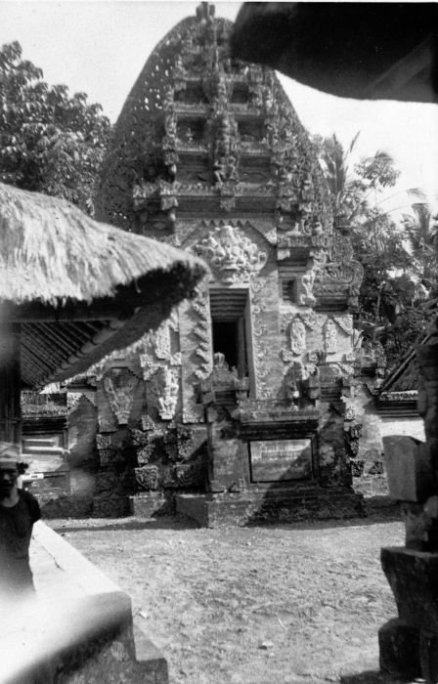
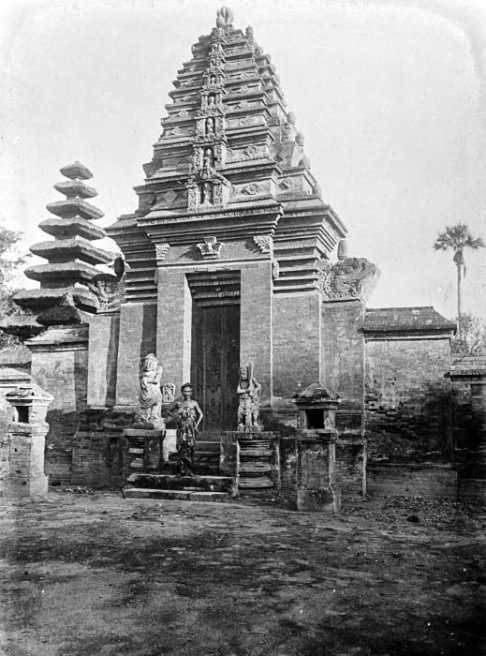
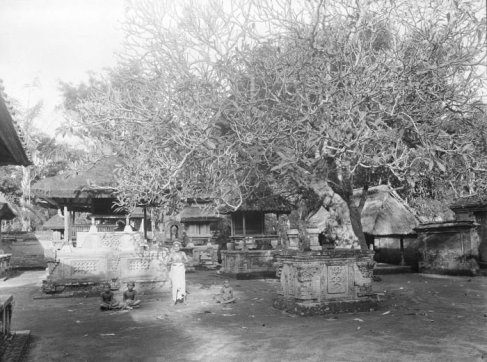 Bali old
Bali old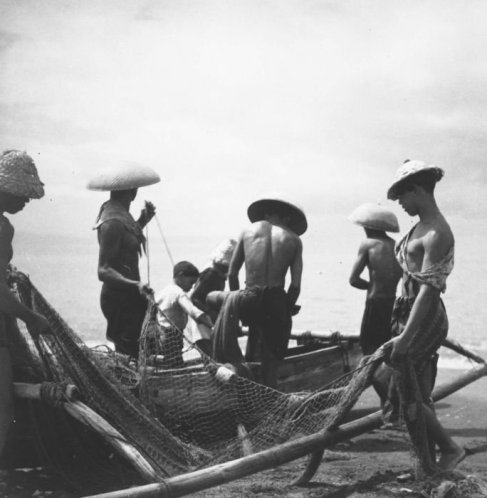 balinese
balinese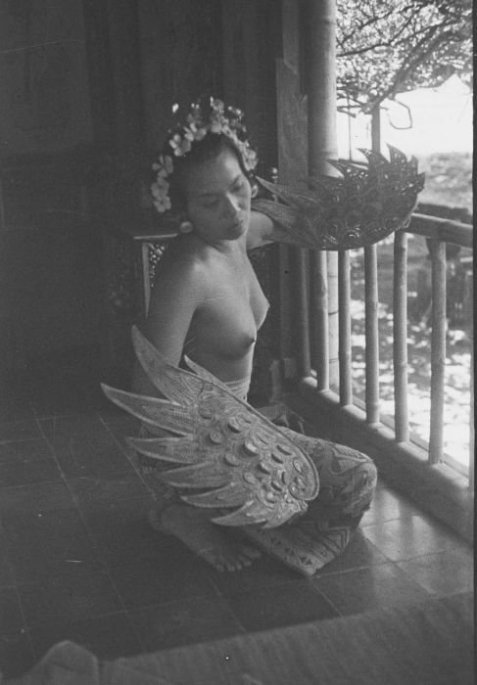 Purdue process, some in the form of plates with inscriptions, drums, and little statues of deities and kings, some classic in style like the beautiful ones found in Java, others of a more primitive, perhaps local style. All of these antiquities are not in museums, but are still the property of the people, kept in the temples and honored because of their antiquity, brought out of their wrappings once a year on the occasion of the temple feast of the village.
Purdue process, some in the form of plates with inscriptions, drums, and little statues of deities and kings, some classic in style like the beautiful ones found in Java, others of a more primitive, perhaps local style. All of these antiquities are not in museums, but are still the property of the people, kept in the temples and honored because of their antiquity, brought out of their wrappings once a year on the occasion of the temple feast of the village.

